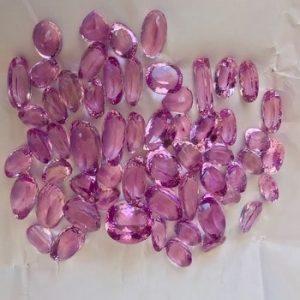One of the most attractive colors in gemstones is pink. Pink diamonds of superior quality and in dimensions of several carats hover around numbers that carry five zeros … to the carat!
Pink sapphires, called padparadscha, are also highly sought after, although they never weigh more than two carats. Some pink tourmalines are considered among the pink stones of great beauty, but it is also rare to find large ones. The quintessential pink gemstone that is commonly found over 10 carats is kunzite and specimens over 20 carats can often be ordered from specialist dealers.
We are talking about one of the most beautiful and delicate gemstones in the world of gems. Of a delicate pink or lilac color – in the case of patroke specimens, in Afghanistan, the lilac color is intense and impressive – this gem has definitely established itself among the favorites for several reasons.
Needless to say, here that as in all cases of colored gemstones, untreated gemstones with good color saturation are the most valuable.
It is a strongly pleochroic gem. The top and bottom of the glass reveal the deepest colors and the gems are cut so the deepest pink shows through the table. This is a complex task and requires an exact knowledge of the material, as well as the cutting technique.
It was discovered in the United States at the Pala mine in San Diego County in 1902 and identified by George Frederick Kunz – hence its name – (Kunzite, in English).
First Lady's Kunzite
Remarkable visibility and popularity achieved this gem in 1996 because of the Sotheby's auction in New York of a 47-carat kunzite ring owned by Jacqueline Kennedy Onassis. The ring was sold for more than $400,000.
It was a white gold ring, and the kunzite was accompanied by 60 small diamonds.
Behind this jewel there is a really moving story. Actually, this ring was John Kennedy 's last gift to his wife from him. He had bought it as a present for Christmas 1963. But she couldn't give it to him personally. On November 22, in Dallas, President JFKennedy was assassinated and both the United States and the rest of the world were paralyzed by the stupor that such a crime produced.
The jeweler contacted Jacqueline a few days later to inform her of her husband's gift. Jacqueline never parted with her ring, and it was one of the jewels she wore most often, even though it was of far less material value than the jewels that were later given to her by her second husband, the Greek tycoon Aristotle Onassis.
The story, I insist, is most moving. It tells us about the emotional value of objects, much higher than the material value. And I know you will like this story because all of them – myself included! – we have a jewel, an earring, a bracelet, a ring that we particularly appreciate, which we would never part with as it represents a memory whose value is so high that it is priceless.

